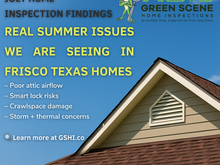TREC 2022 Update and 2020 NEC Changes (video)
- Green Scene Home Inspections
- Feb 1, 2022
- 5 min read

PURPOSE OF INSPECTION
A real estate inspection is a visual survey of a structure and a basic performance evaluation of the systems and components of a building. It provides information regarding the general condition of a residence at the time the inspection was conducted. It is important that you carefully read ALL of this information. Ask the inspector to clarify any items or comments that are unclear.
RESPONSIBILITY OF THE INSPECTOR
This inspection is governed by the Texas Real Estate Commission (TREC) Standards of Practice (SOPs), which dictates the minimum requirements for a real estate inspection.
The inspector IS required to:
Use this Property Inspection Report form for the inspection
Inspect only those components and conditions that are present, visible, and accessible at the time of the Inspection
Indicate whether each item was inspected, not inspected, or not present
Indicate an item as Deficient (D) if a condition exists that adversely and materially affects the performance of a system or component OR constitutes a hazard to life, limb or property as specified by the SOPs
Explain the inspector’s findings in the corresponding section in the body of the report form
The inspector IS NOT required to:
Identify all potential hazards
Turn on decommissioned equipment, systems, utilities, or apply an open flame or light a pilot to operate any appliance
Climb over obstacles, move furnishings or stored items
Prioritize or emphasize the importance of one deficiency over another
Provide follow-up services to verify that proper repairs have been made; or inspect system or component listed under the optional section of the SOPs (22 TAC 535.233)
RESPONSIBILITY OF THE CLIENT While items identified as Deficient (D) in an inspection report DO NOT obligate any party to make repairs or take other actions, in the event that any further evaluations are needed, it is the responsibility of the client to obtain further evaluations and/or cost estimates from qualified service professionals regarding any items reported as Deficient (D). It is recommended that any further evaluations and/or cost estimates take place prior to the expiration of any contractual time limitations, such as option periods. Please Note: Evaluations performed by service professionals in response to items reported as Deficient (D) on the report may lead to the discovery of additional deficiencies that were not present, visible, or accessible at the time of the inspection. Any repairs made after the date of the inspection may render information contained in this report obsolete or invalid.
REPORT LIMITATIONS This report is provided for the benefit of the named client and is based on observations made by the named inspector on the date the inspection was performed (indicated above). ONLY those items specifically noted as being inspected on the report were inspected. This inspection IS NOT:
A technically exhaustive inspection of the structure, its systems, or its components may not reveal all deficiencies
An inspection to verify compliance with any building codes
An inspection to verify compliance with manufacturer’s installation instructions for any system or component and DOES NOT imply insurability or warrantability of the structure or its components.
NOTICE CONCERNING HAZARDOUS CONDITIONS, DEFICIENCIES, AND CONTRACTUAL AGREEMENTS
Conditions may be present in your home that did not violate building codes or common practices in effect when the home was constructed but are considered hazardous by today’s standards. Such conditions that were part of the home prior to the adoption of any current codes prohibiting them may not be required to be updated to meet current code requirements. However, if it can be reasonably determined that they are present at the time of the inspection, the potential for injury or property loss from these conditions is significant enough to require inspectors to report them as Deficient (D). Examples of such hazardous conditions include:
malfunctioning, improperly installed, or missing ground fault circuit protection (GFCI) devices and arc-fault (AFCI) devices
Ordinary glass in locations where modern construction techniques call for safety glass
Malfunctioning or lack of fire safety features such as smoke alarms, fire-rated doors in certain locations, and functional emergency escape and rescue openings in bedrooms
Malfunctioning carbon monoxide alarms
Excessive spacing between balusters on stairways and porches
Improperly installed appliances
Improperly installed or defective safety devices
Lack of electrical bonding and grounding
Lack of bonding on gas piping, including corrugated stainless steel tubing (CSST)
Please Note: Items identified as Deficient (D) in an inspection report DO NOT obligate any party to make repairs or take other actions. The decision to correct a hazard or any deficiency identified in an inspection report is left up to the parties to the contract for the sale or purchase of the home.
REI 7-6 (8/9/21) • Promulgated by the Texas Real Estate Commission • (512) 936-3000 • www.trec.texas.gov

2020 NEC Changes
Article 210.8 GFCI Ground-Fault Circuit-Interrupters or GFCI's
The distance shall be the shortest path the cord of an appliance connected to a receptacle would follow without piercing a floor, wall, ceiling, or fixed barrier or passing through a window.
They Removed Door and Doorway
Article210.8 (A) (5)
GFCI Ground-Fault Circuit-Interrupters or GFCI's
Basements- Any outlet in a basement must be GFCI protected.
Article 210.8 (F)
Outdoor Outlets
All outdoor outlets for dwelling unit supplied by single-phase, branch circuit rated 150V or less, or 50A or less shall be GFCI protected.
Examples:
AC condenser
Heat Pumps
Septic Aerators
Well Pumps
Article 210.8 (A)
Outlets
All 120V through 250V receptacle outlets specified in A(1) through A(11) shall be GFCI protected within 6ft of the inside edge of a sink basin.
Article 210.52 (C)
Island or Peninsula Outlets
At least one receptacle required in the first nine square feet of an island or peninsula and a receptacle for every 18 square feet or fraction thereafter. There must be at least one receptacle within the first two foot of the end of a counter.
Article230.85
Emergency Disconnects
Requires one and two-family dwelling units to have an emergency disconnect installed in an outdoor readily accessible location and to be labeled as an emergency disconnect.
Article 230.67
Surge Protection
Requires installation of surge protection devices In all dwelling unit services.
This requirement came about from the need to not only protect electronic equipment in your home but also to protect important life safety devices such as smoke alarms GFCIs and AFCI's from the damaging effects of surge.
It is also important to select the type 1 or type 2 surge device that provides the level of protection that you desire for your installation factors that should be considered include:
Short-circuit current rating (SCCR)
Nominal discharge current rating (In)
Voltage protection rating. VPR)
That is the last of the updates, we hope you all enjoyed the video breakdown as much as we enjoyed making it! We would love to hear from you via social media @greenscenehome or reach out to us via #AskAHomeInspector. P.S. Keep an eye out for our Knowledge is Power: Realtor Education























Comments